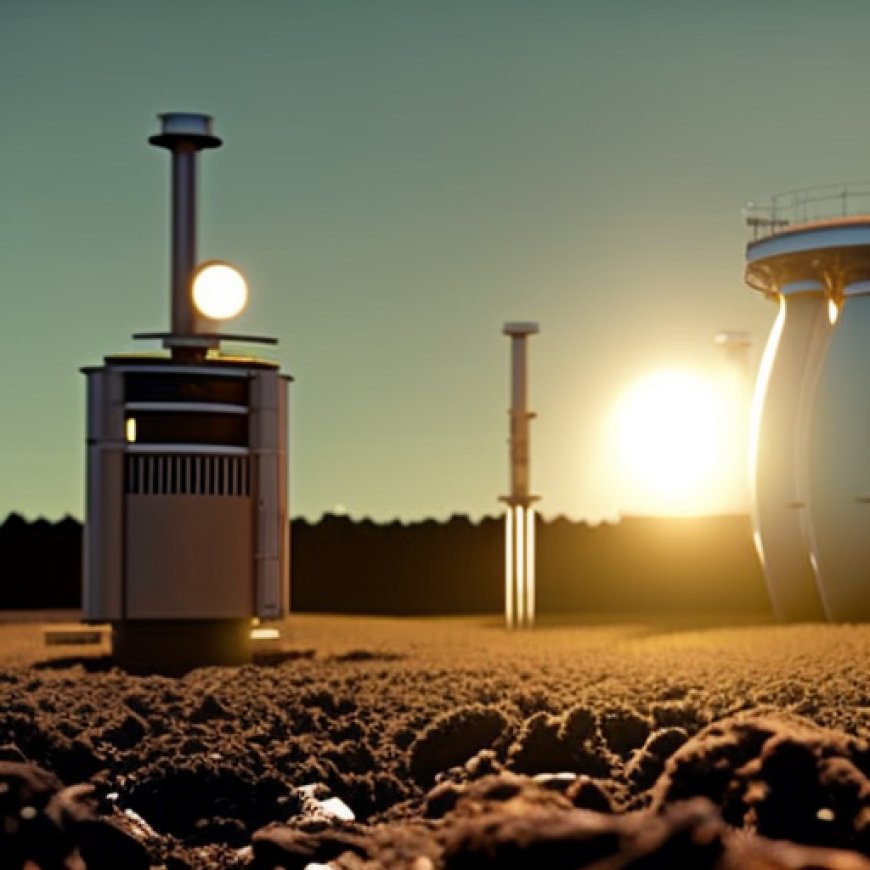Anaerobic digestion 4.0: How smart tech is modernising the AD energy sector
Anaerobic digestion 4.0: How smart tech is modernising the AD ... BusinessGreen


Anaerobic Digestion 4.0: Revolutionizing Renewable Energy

Anaerobic digestion (AD) is a proven industry that has been around since the 19th Century. But recent innovations such as automation, IoT (Internet of Things) and AI offer a raft of opportunities for the AD sector to have a far greater impact than it ever has had in the past. We are now in the fourth industrial revolution – and so here comes what we like to call ‘Anaerobic Digestion 4.0’.
The Sustainable Development Goals (SDGs)
AD offers a circular and environmentally friendly solution to treat millions of tonnes of organic feedstocks including food waste, transforming it into a reliable and stable source of locally produced, renewable energy for homes, businesses, and vehicles. This aligns with several Sustainable Development Goals (SDGs), including:
- SDG 7: Affordable and Clean Energy
- SDG 9: Industry, Innovation, and Infrastructure
- SDG 11: Sustainable Cities and Communities
- SDG 12: Responsible Consumption and Production
- SDG 13: Climate Action
The Anaerobic Digestion Process
On a basic level, AD mimics the natural process that occurs daily in our bodies when we consume food – breaking it down and producing energy. However, instead of taking place in our stomachs, AD takes place in large tanks.
While anaerobic digestion is proven to be an effective technology, scaling it up to meet the need for reliable and localized renewable energy is more critical than ever with countries such as the UK striving to achieve their ambitious net zero targets. Estimates suggest that by 2030, the AD sector could generate 5.7 billion cubic meters of home-grown biomethane a year – enough to heat 4.5 million homes.
Currently, a significant amount of food waste is sent to landfill, where it decomposes and releases harmful greenhouse gases. In the UK alone, around 9.5 million tonnes of food waste are discarded annually, emitting approximately 25 million tonnes of greenhouse gases each year. This accounts for 5.5 per cent of the country’s total emissions, exceeding the annual emissions of the whole of the Republic of Ireland.
Moreover, local authorities are being mandated by the UK government to implement a solution to food waste in their area. Anaerobic digestion can divert food waste from landfill, mitigating the release of methane and turning it into a valuable energy source.
Launching Anaerobic Digestion 4.0
Creating AD 4.0 combines an AD process with the capabilities of Industry 4.0 technologies for enhanced efficiency, monitoring, and control. This integration aligns with SDG 9: Industry, Innovation, and Infrastructure.
This is made possible through a cloud-based site management solution that can significantly help in data collection at AD plants – with real-time visibility, centralized data storage, and efficient collaboration. These are:
- Remote access & real-time data monitoring: Cloud-based solutions that integrate with various sensors and data collection devices installed at sites.
- Centralized data storage: Automated data collection negates the need for manual data entry.
- Automated data collection: Smart cameras at all sites that import real-time readings to a cloud-based data acquisition system.
- Data analytics and reporting: Real-time operational and management dashboards to identify patterns, trends, and data to optimize plant operations, improve efficiency, and identify potential maintenance requirements.
- Collaboration and communication: The integration of data and analytics enables collaboration among different stakeholders involved in the operation and management of plants.
Artificial Intelligence
We are also likely to see the introduction of artificial intelligence (AI) and machine learning (ML) tools in AD plants in the not-so-distant future. ML tools can be used to optimize the AD process further by predicting the optimal conditions for maximum methane production and the performance of digesters.
Overall, automation technology has the potential to make anaerobic digestion a more efficient, safer, reliable, and sustainable way to produce renewable energy. As this technology continues to develop, it is likely to play an increasingly important role in the UK’s low carbon energy future. By continually improving and scaling up these technologies, Bio Capital and the AD industry as a whole can make a tangible impact on the environment and assist the UK’s ambitious emission goals.
Karan Tyagi is head of business intelligence at Bio Capital.
SDGs, Targets, and Indicators
| SDGs | Targets | Indicators |
|---|---|---|
| SDG 7: Affordable and Clean Energy | 7.2: Increase the share of renewable energy in the global energy mix | – The amount of renewable energy generated from anaerobic digestion – The percentage increase in the use of renewable energy in the UK |
| SDG 12: Responsible Consumption and Production | 12.3: Cut food waste in half and reduce food losses along the production and supply chains | – The amount of food waste diverted from landfill through anaerobic digestion – The reduction in greenhouse gas emissions from food waste decomposition |
| SDG 13: Climate Action | 13.2: Integrate climate change measures into national policies, strategies, and planning | – The reduction in greenhouse gas emissions from the AD sector – The contribution of AD to the UK’s emission reduction goals |
| SDG 9: Industry, Innovation, and Infrastructure | 9.4: Upgrade infrastructure and retrofit industries to make them sustainable | – The adoption of Industry 4.0 technologies in AD plants – The improvement in efficiency and safety through automation and AI |
1. Which SDGs are addressed or connected to the issues highlighted in the article?
SDG 7: Affordable and Clean Energy
The article discusses how anaerobic digestion can transform organic feedstocks into renewable energy for homes, businesses, and vehicles. This aligns with SDG 7, which aims to ensure access to affordable, reliable, sustainable, and modern energy for all.
SDG 12: Responsible Consumption and Production
The article highlights the issue of food waste and how anaerobic digestion can divert food waste from landfill, reducing greenhouse gas emissions. This relates to SDG 12, which focuses on promoting sustainable consumption and production patterns.
SDG 13: Climate Action
The article mentions the harmful greenhouse gases released from food waste decomposition in landfills and emphasizes the role of anaerobic digestion in mitigating methane emissions. This connects to SDG 13, which aims to take urgent action to combat climate change and its impacts.
SDG 9: Industry, Innovation, and Infrastructure
The article discusses the integration of Industry 4.0 technologies, such as automation, IoT, and AI, in anaerobic digestion plants for enhanced efficiency and control. This aligns with SDG 9, which focuses on building resilient infrastructure, promoting inclusive and sustainable industrialization, and fostering innovation.
2. What specific targets under those SDGs can be identified based on the article’s content?
Target 7.2: Increase the share of renewable energy in the global energy mix
The article highlights the potential of anaerobic digestion to generate renewable energy from organic feedstocks. Achieving this potential can contribute to increasing the share of renewable energy in the global energy mix.
Target 12.3: Cut food waste in half and reduce food losses along the production and supply chains
The article emphasizes how anaerobic digestion can divert food waste from landfill, reducing greenhouse gas emissions. By implementing anaerobic digestion solutions, progress can be made towards cutting food waste in half and reducing food losses.
Target 13.2: Integrate climate change measures into national policies, strategies, and planning
The article highlights the role of anaerobic digestion in mitigating methane emissions from food waste decomposition. Integrating anaerobic digestion into national policies and strategies can contribute to climate change mitigation efforts.
Target 9.4: Upgrade infrastructure and retrofit industries to make them sustainable
The article discusses the adoption of Industry 4.0 technologies in anaerobic digestion plants for enhanced efficiency, monitoring, and control. Upgrading infrastructure with these technologies can contribute to making the AD industry more sustainable.
3. Are there any indicators mentioned or implied in the article that can be used to measure progress towards the identified targets?
The article mentions or implies several indicators that can be used to measure progress towards the identified targets:
– The amount of renewable energy generated from anaerobic digestion can be measured to assess progress towards increasing the share of renewable energy in the global energy mix (Target 7.2).
– The amount of food waste diverted from landfill through anaerobic digestion can be measured to track progress towards cutting food waste in half (Target 12.3).
– The reduction in greenhouse gas emissions from the AD sector can be measured to evaluate progress towards integrating climate change measures into national policies (Target 13.2).
– The adoption of Industry 4.0 technologies in AD plants and the improvement in efficiency and safety through automation and AI can be measured to assess progress towards upgrading infrastructure and retrofitting industries (Target 9.4).
4. SDGs, Targets, and Indicators
| SDGs | Targets | Indicators |
|---|---|---|
| SDG 7: Affordable and Clean Energy | 7.2: Increase the share of renewable energy in the global energy mix | – The amount of renewable energy generated from anaerobic digestion – The percentage increase in the use of renewable energy in the UK |
| SDG 12: Responsible Consumption and Production | 12.3: Cut food waste in half and reduce food losses along the production and supply chains | – The amount of food waste diverted from landfill through anaerobic digestion – The reduction in greenhouse gas emissions from food waste decomposition |
| SDG 13: Climate Action | 13.2: Integrate climate change measures into national policies, strategies, and planning | – The reduction in greenhouse gas emissions from the AD sector – The contribution of AD to the UK’s emission reduction goals |
| SDG 9: Industry, Innovation, and Infrastructure | 9.4: Upgrade infrastructure and retrofit industries to make them sustainable | – The adoption of Industry 4.0 technologies in AD plants – The improvement in efficiency and safety Behold! This splendid article springs forth from the wellspring of knowledge, shaped by a wondrous proprietary AI technology that delved into a vast ocean of data, illuminating the path towards the Sustainable Development Goals. Remember that all rights are reserved by SDG Investors LLC, empowering us to champion progress together. Source: businessgreen.com
Join us, as fellow seekers of change, on a transformative journey at https://sdgtalks.ai/welcome, where you can become a member and actively contribute to shaping a brighter future.
|








